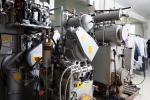CHICAGO — Getting new equipment is a big day for any drycleaning store or plant, but it can also cause interruptions and disruptions during installation and the first days of use.
Or, worse, what if the equipment doesn’t fit through the door on installation day?
Dry cleaners and their staff can minimize downtime and take full advantage of the new tools at their disposal by asking some questions and taking some steps before the new machinery arrives.
Getting Ready
Planning for installation — and any possible downtime that will be involved — is key, says Matt Lipman, sales representative for Union Drycleaning Products. This also involves looking at the big picture when it comes to the entire facility.
“I encourage people to check out the utilities in advance,” he says. “If your machine needs electricity, air, steam, water, or what have you, you need to make sure you have the correct sources. That’s probably the No. 1 thing that causes us problems in the field is they think their boiler is big enough, but it’s not. They think the chiller is big enough, but it’s not. They think they have the right size (circuit) breaker, but they don’t. So, all those things can be done in advance.”
“Get a cut sheet on the piece of equipment, which generally has all the specs, and go over that,” agrees Wesley Nelson, president of Sankosha USA. He notes that dry cleaners should also look at the physical space that the new equipment will be going into.
“It’s always good to talk to the manufacturer and the distributor,” he says. “Most manufacturers and distributors are able to provide layouts and do some CAD drawings. Normally, we’ll do an on-site visit and just see what the customer is trying to get accomplished. And that way, once you’ve installed it, you don’t have to move it again. You get things right the first time, and you don’t end up with a plant that’s inefficient.”
Lipman believes this type of planning is crucial for a smooth installation.
“I like to have a clear timeline for the entire process,” he says. “I always sit down and talk to customers. Again, the first thing you check are the utilities and the space. Then, we put together a schedule, with a day for the installation and a day for the training. We need a clear timeline and a set of goals to get the task completed.”
Failing to get one particular question answered can lead to major headaches on installation day, says Nelson.
“Make sure you can get the equipment from the outside of the building into the spot it needs to be in,” he says. “Make sure that if there are height issues or width issues, all of that is addressed ahead of time. Normally, a good installer or distributor would take care of that for people, but just make sure that there aren’t any issues with ingress.”
Questions Asked and Answered
Before planning for installation day, Nelson and Lipman each say there are certain questions they like to hear from cleaners so they can better assist them in finding the right equipment for their specific needs.
“I like questions along the lines of, ‘What type of garments can the new equipment do well?’ and ‘What kind of garments might that new piece not do as well?,’” Nelson says. “I just want to make sure it’s a good fit for them upfront. Other questions I like are, ‘Who in my area has this piece of equipment? Who can I talk to about it? Where can I go to see it?’ That way, especially with a larger or more expensive piece of equipment, they’re absolutely sure that’s the right machine for them, and we always welcome that.”
“I always look for how production could be improved,” Lipman says. “For that, typically you’re going to ask, ‘How much labor can I save?’ If you’re looking at replacing two small machines with one bigger machine, are you going to save labor? Are you going to save time, which is directly related to labor?”
It’s also wise, Lipman advises, to take future-proofing into account when buying equipment, especially when evaluating large pieces of machinery.
“The one big mistake I see people make is that they don’t look for growth,” he says. “They look at, ‘This is what I’m doing today. This is all I’m ever going to do.’ If, for marginally more money, they’re able to go to a slightly bigger size or a different design, they can look at the future for growth for their business. When they install one machine, do they want to leave room for two machines? I hate to use (an) old cliche, but not thinking of the future can be ‘penny-wise and pound-foolish.’”
Come back Tuesday for Part 2 of this series, where we’ll examine how to ensure that team members work well with new equipment, and all the plant’s equipment works with well together.
Have a question or comment? E-mail our editor Dave Davis at [email protected].





















